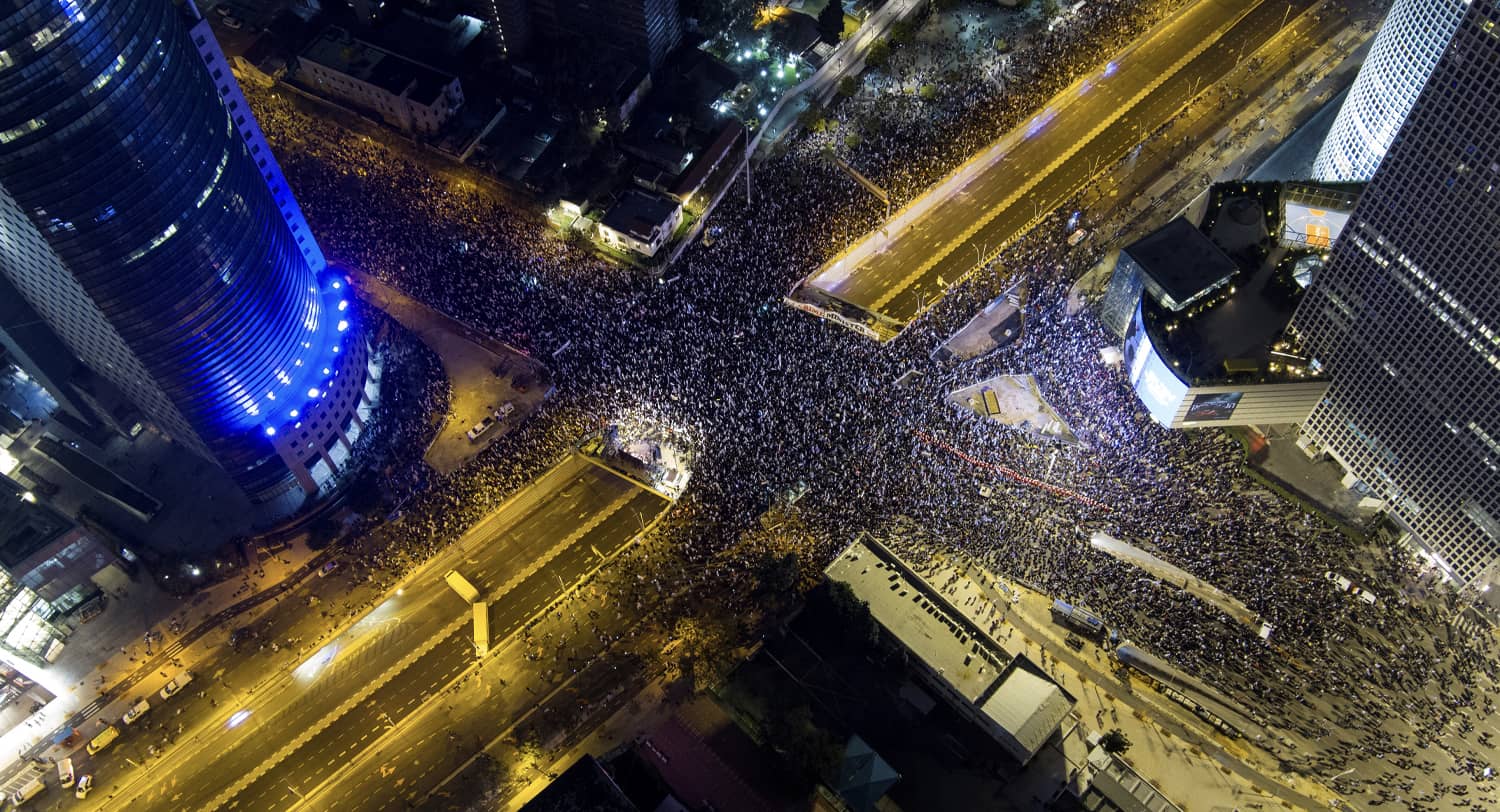Since December 2022, every Saturday evening after Shabbat, tens of thousands of Israelis have demonstrated against the judicial reform proposals of Prime Minister Netanyahu’s government. Former generals and judges, economists, journalists, hi-tech professionals, medical workers, shopkeepers, young students and their grandparents who fought in the War of Independence, native-born Israelis and recent immigrants, and Arab citizens of Israel have joined hands and voices.
The images taken from the top of Tel Aviv office towers during the demonstrations show a human river completely filling Kaplan Street—feeding into Habima Square—and all of the adjacent streets, giving the protest a stunning appearance. These rallies are taking place all around Israel. At its height, more than a quarter of a million Israelis assembled in front of the Knesset in Jerusalem on Monday, February 13, when the parliamentary committee on legislation was holding a vote on the judicial reforms.
What do the protestors want? They appear united on the danger posed by the current government to the independence of the judiciary and thus to liberal democracy and the rule of law. The overwhelming majority believe Netanyahu should no longer be the nation’s leader. However, they sharply disagree on the issue of the alternative, and this is nothing new. During the 16-month period leading up to the elections last November, Israel had two prime ministers—Naftali Bennett and Yair Lapid—and a third would-be leader—Benny Gantz. Lapid and Gantz appeared more like rivals than allies throughout last year’s electoral campaign. Many inside Merav Michaeli’s Labor Party believe that she is to blame for the shockingly low performance of the center-left because she refused to bring the left-wing Meretz Party into an electoral bloc with Labor. Although the media has relentlessly criticized the Likud’s “Bibi-cult,” its opponents have not been able to coalesce around a unifying ideology or leader.
This is a protest movement without a leader. The leaders of the opposition parties in the Knesset, Yair Lapid and Benny Gantz, are welcomed as ordinary protesters and frequently are not even given the opportunity to speak at the demonstrations. Civil society organizations in Israel coordinate and organize the protests. Some believe that this lack of leadership is actually a benefit, since it allows Israelis who do not belong to the center-left camp to join the protests. Others are hopeful that a charismatic and decent leader—whether a figure from the past or a new grassroot leader—will emerge sometime soon.
One name reemerging from the protest movement is Tzipi Livni, the former minister of justice and foreign affairs who left politics in 2019 (disclaimer: I served in the 20th Knesset for her party, Ha-Tnua). A quick peek at her Twitter and Facebook reveals the support and yearning of thousands of Israelis who think she would be the ideal candidate at this time. Livni has not released any information about her upcoming political aspirations as of yet. In recent years, she has seemed reluctant to rejoin the stormy Israeli politics.
And there is Avi Himi, the former president of the Israel Bar Association who, as a Sephardic Jew, a self-made man, and a staunch opponent of the judicial reforms, briefly appeared to be the ideal candidate. But Israel’s Channel 13 accused Himi of harassing a young female lawyer the day after an interview with him appeared in the Haaretz weekend magazine. The police decided to probe the story, while Himi claimed that he was romantically involved with the woman and blamed his opponents for framing him. In the meantime, Himi’s nascent leadership has become a moot point.
Could a leaderless protest succeed? History is replete with instances. The most recent examples are the Ukrainian Maidan Revolution in 2014 and the Arab Spring in 2011. The Arab Spring fell short of expectations for a number of reasons, bringing neither democracy nor prosperity. The protests in Ukraine’s Maidan Square were more successful—the pro-Russian president was ousted and democratic elections were held.
Leaderless protests have advantages and disadvantages. Without a leader, they are less vulnerable to political pressure, as there is no leader to frame or pressure. Additionally, it is much simpler for people to join the protest when it is not associated with just one person or political organization, allowing a wider spectrum of groups to participate. However, there is often a great benefit in having a revered and respected leader, a charismatic and bright woman or man who could inspire the masses and lead the way.
The current tidal wave of protests demonstrates the strength of civil society in Israel. But it also reveals the weakness of the political parties of the left. While current political leaders will fight for their place under the sun, some new figures might emerge and change the face of Israeli politics in the future.

